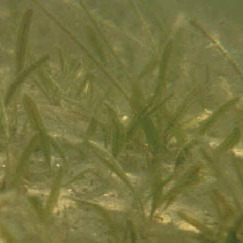Monoecious or dioecious, submerged, marine perennials. Stems elongate, rhizomatous or shortly erect, the latter produced from nodes at regular intervals along the rhizome. Roots 1(–3) at each node where the erect stems produced, simple, sand binding, covered with fine hairs. Leaves in pairs, whorls or distichously arranged on the erect stems, sessile or petiolate; blade linear to ovate, acute, obtuse or rounded, cuneate or rounded at the base, opaque or somewhat translucent, usually glabrous, rarely sparsely pubescent, with 3 longitudinal veins, often connected by ascending cross-veins; margins green, entire or serrulate. Stipules 2, obtuse to suborbicular or transversely elliptic, membranous, subtending each pair or whorl of leaves. Nodal scales 0. Flowers unisexual. Male and ♀ spathes similar, solitary in leaf-axils, sessile, 1–2-flowered, rarely with 1 flower of each sex in the same spathe, composed of 2 free, overlapping bracts, the bracts elliptic to sub-orbicular, acuminate, obtuse, often keeled, translucent, the margins entire or serrulate. Male flowers pedicellate, remaining attached to the plant; tepals 3, ovate, cucullate; stamens 3, anthers sessile, linear-oblong, erect, 2–4-thecous, latrorsely or extrorsely dehiscent. Female flowers with tepals 3, reduced to lobes at the apex of perianth-tube; staminodes 0; ovary of 3–5 carpels, ellipsoid or ovoid, 1-locular, placentation parietal; ovules few to many; perianth-tube narrowly cylindric; styles 3–5; stigmas 3–5, filiform, entire. Fruit ovoid to globose, membranous, opening by decay of pericarp. Seeds subglobose to globose, tuberculate, reticulate or smooth.
Monoecious or dioecious. Stems creeping, ramified, rooting at the nodes with 1, rarely more unramified roots closely set with fine root-hairs. At the nodes 2 scales, one embracing the stem, the other embracing a lateral, often undeveloped shoot, which bears the leaves (rarely with 2 scales below these leaves). Leaves opposite, sessile or petioled, linear, lanceolate, oblong-elliptic or ovate, entire or serrulate, rarely hairy; nerves 3, a midrib and on both sides an intramarginal nerve, almost always connected by cross-veins; between the leaves a new shoot appears which again bears scales and 1 or more pairs of leaves, and the inflorescence. Spathe sessile, composed of 2 membranous free bracts, one embracing the other, elliptic, obovate to suborbicular, acute, rounded to emarginate or indented, keeled, keel sometimes serrulate; margin entire, rarely ciliate or serrulate. Flowers unisexual, solitary, rarely 1 or more male and one female flower in one spathe. Male flower pedicelled; perianth segments 3, imbricate; stamens 3, alternating with the tepals, anthers sessile, 2-4-celled, dehiscent extrorsely; pollen grains in long chains. Female flower sessile, or almost so. Ovary elliptic or ovate, 1-celled, at the apex with a long beak crowned by the 3 reduced tepals, styles linear, (2-)3-5. Fruit ovate, rostrate, 1-celled; wall membranous. Seeds few to numerous, globose or subglobose.
Plants of marine waters. Rhizomes present; leaf-bearing branches arising from rhizome at each node; stolons absent. Erect stems, if present, rooted in substrate, unbranched, short; scales 2, midway or higher on stem. Leaves 2--8, terminal pairs or pseudowhorls [distichous], submersed, sessile or petiolate; blade linear to ovate, base tapering to stem; apex obtuse; midvein without lacunae along side(s), blade uniform in color throughout; abaxial surfacely without prickles; intravaginal squamules entire. Inflorescences 1-flowered or cymose, sessile; spathes not winged. Flowers unisexual, staminate and pistillate on same plants or on different plants, submersed, sessile, nearly sessile (pistillate), or pedicellate (staminate); petals absent. Staminate flowers: filaments distinct; anthers linear to fusiform; pollen in moniliform chains. Pistillate flowers: ovary 1-locular; styles 3--5, not 2-fid. Fruits ovoid to spheric, smooth or ridged, not echinate, dehiscing by decay of pericarp. Seeds spheric or nearly so, echinate to reticulate.
Marine to estuarine, sometimes intertidal, submerged, monoecious or dioecious, annual or perennial herbs. Rhizomes creeping, with 1 lateral shoot and 1 unbranched root at each node. Scales 2, one covering root base and the other covering lateral shoot base. Leaves in pairs or in pseudowhorls, sessile or petiolate; blades linear, lanceolate to ovate, entire or serrulate, glabrous or hairy, with a midvein and 2 marginal veins usually connected by cross-veins; tannin cells absent; stomata absent. Spathe with 2 imbricate, keeled bracts; 1-flowered or with a male and a female flower. Male flower pedicellate; tepals 3; stamens 3; anthers 2, oblong, sessile, dehiscing longitudinally; pollen grains ellipsoid, in long chains. Female flower sessile; hypanthium persistent, bearing 3 reduced tepals; ovary ovoid to ellipsoid, unilocular; styles 3–6, filiform. Fruit ellipsoid to globose, beaked. Seeds numerous, globose; testa mostly reticulate.
Herbs, submerged marine. Stems slender, easily breaking, creeping, branched, rooting at nodes, with 2 scales at each node. Leaves usually opposite or binate, usually petiolate, margin entire or serrulate. Plants dioecious or monoecious; flowers unisexual. Spathes 2-valved, sessile, usually 1-flowered. Male flowers pedicellate; perianth segments 3; stamens 3, alternate with perianth segments, filament absent; anthers 2-4-thecous, extrorse; pollen moniliform. Female flowers sessile or subsessile; ovary with an apical beak; beak expanded at apex into 3 minute perianth lobes; ovules 2 to numerous; styles (2 or)3-5, threadlike. Fruit with beak at apex; pericarp membranous. Seeds few to many, globose or subglobose.
Leaves differentiated into a petiole and a blade; leaf blades ovate, elliptic, or lanceolate; tannin cells absent. Flowers unisexual, solitary. Male flowers pedicellate, with 3 tepals and 3 stamens. Female flowers consisting of a sessile ovary with reduced perianth and a style with 3-5(-6) stigmata
Lateral shoot halfway or higher up with 2 scales and at the top 2 or 3 pairs of pseudoverticillate leaves.
Lateral shoot short, 1 cm or smaller, often not developed, with only 1 pair of leaf blades at the top.
Lateral shoot 1-2 cm, with 6-10 leaf blades at the top, petiole with a broad sheath.
Lateral shoot long, with 15-20 pairs of sessile, distichous leaves.

